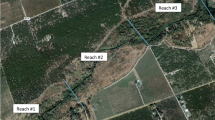Abstract
The restoration of a natural riparian ecosystem is a key component to improving water quality and restoring stream health in a disturbed watershed. The rate and degree of riparian restoration, and hence stream restoration, depends in part upon afforestation practices. Successful afforestation is determined largely by the rates of survivorship and growth of the tree species planted or recruited in a riparian zone. This study was part of a project involving the restoration of a channelized section of Wilson Creek located in the Bernheim Arboretum and Research Forest, Nelson County, Kentucky. Riparian restoration activities focused on reestablishing a native riparian corridor using American sycamore (Platanus occidentalis), green ash (Fraxinus pennsylvanica var. subintegerrima), and pin oak (Quercus palustris). This study evaluated techniques for improving the growth and survivorship of planted seedlings along Wilson Creek. Specifically, two tree shelter types (Tubex® vs. continental mesh), with or without herbicide treatments, were compared. Additionally, the influence of these techniques on debris retention within the riparian zone was also examined. Results showed that use of tree shelters significantly increased the growth of seedlings (but not survivorship), provided physical protection especially during heavy flooding events, and accelerated woody debris retention. Both Tubex® and continental mesh tree shelters were effective in enhancing seedling growth, with Tubex® shelters yielding significantly better growth when combined with herbicide to control competing vegetation. Thus, the most cost effective choice may depend on the environmental setting and ability to combine the shelters with other growth enhancing treatments.


Similar content being viewed by others
References
Allen K (1994) Insects and diseases of oak seedlings grown in tree shelters. Tree Planters’ Notes 45(3):88–90
Bukaveckas PA (2007) Effects of channel restoration on water velocity, transient storage and nutrient uptake in a channelized stream. Environ Sci Technol 41:1570–1576
Conner WH, Inabinette LW, Brantley EF (2000) The use of tree shelters in restoring forest species to a floodplain delta: 5-year results. Ecol Eng 15:S47–S56
Correll DL (2005) Principles of planning and establishment of buffer zones. Ecol Eng 24:433–439
Dattilo AJ (2003) Riparian restoration: reference forest characterization and Canebreak establishment in the Western Knobs of Kentucky. M.S. thesis, University of Kentucky, Lexington
Dubois MR, Chappelka AH, Robbins E, Somers G, Baker K (2000) Tree shelters and weed control: effects on protection, survival and growth of cherrybark oak seedlings planted on a cutover site. New For 20:105–118
DuPlissis J, Yin X, Baughman MJ (2000) Effects of site preparation, seedling quality, and tree shelters on planted northern red oaks. Staff Paper Series No.141. College of Natural Resources and Minnesota Agricultural Experiment Station University of Minnesota, St Paul
Gerhold HD (1999) Species differ in responses to tree shelters. J Arboric 25(2):76–80
Goodwin CN, Hawkins CP, Kershner JL (1997) Riparian restoration in the western United States: overview and perspective. Restor Ecol 5(4S):4–14
Gregory SV, Swanson FJ, McKee WA, Cummins KW (1991) An ecosystem perspective of riparian zones. BioScience 41(8):540–551
Krekeler N, Kabrick JM, Dey DC, Wallendorf M (2006) Comparing natural and artificial methods for establishing pin oak advanced reproduction in bottomland forests managed as greentree reservoirs. USDA Forest Service General Technical Report SRS-92. Southern Research Station. Asheville, North Carolina, pp 224–228
Lantagne D (1989) Increasing hardwood planting success using tree shelters. Forest fact sheet 12. Michigan State University Extension, Lansing
McClure JM, Kolka RK, White A (2004) Effect of forest harvesting best management practices on coarse woody debris distribution in stream and riparian zones in three Appalachian watersheds. Water Air Soil Pollut Focus 4:245–261
Naiman RJ, Décamps H (1997) The ecology of interfaces: riparian zones. Annu Rev Ecol Syst 28:621–658
Opperman JJ, Merenlender AM (2000) Deer herbivory as an ecological constraint to restoration of degraded riparian corridors. Restor Ecol 8(1):41–47
Palmer MA, Bernhardt ES, Allan JD, Lake PS, Alexander G et al (2005) Standards for ecologically successful river restoration. J Appl Ecol 42:208–217
Peterjohn WT, Correll DL (1984) Nutrient dynamics in an agricultural watershed: observations on the role of a riparian forest. Ecology 65(5):1466–1475
Quarterman E, Powell RL (1978) Potential Ecological/Geological Natural Landmarks of the Interior Low Plateaus. US Department of Interior, Park Service, Washington, DC, p 738
SAS Institute (1999) SAS version 9 for windows. SAS Institute, Cary
Stange EE, Shea KL (1998) Effects of deer browsing, fabric mats, and tree shelters on Quercus rubra seedlings. Restor Ecol 6(1):29–34
Sweeney BW (1992) Streamside forests and the physical, chemical, and trophic characteristics of Piedmont streams in eastern North American. Water Sci Technol 26(12):2653–2673
Sweeney BW, Czapka SJ (2004) Riparian forest restoration: why each site needs an ecological prescription. For Ecol Manag 192:361–373
Sweeney BW, Czapka SJ, Yerkes T (2002) Riparian forest restoration: increasing success by reducing plant competition and herbivory. Restor Ecol 10(2):392–400
Sweeney BW, Bott TL, Jackson JK, Kaplan LA, Newbold JD et al (2004) Riparian deforestation, stream narrowing, and loss of stream ecosystem services. Proc Natl Acad Sci 101(39):14132–14137
Tuley G (1983) Shelters improve the growth of young trees in the forest. J For 77:77–87
Tuley G (1985) The growth of young oak trees in shelters. Forestry 58(2):181–195
West DH, Chappelka AH, Tilt KM, Ponder HG, Williams JD (1999) Effects of tree shelters on survival, growth, and wood quality of eleven tree species commonly planted in the southern United States. J Arboric 25(2):69–75
Wissmar RC, Beschta RL (1998) Restoration and management of riparian ecosystems: a catchment perspective. Freshw Biol 40:571–585
Author information
Authors and Affiliations
Corresponding author
Rights and permissions
About this article
Cite this article
Andrews, D.M., Barton, C.D., Czapka, S.J. et al. Influence of tree shelters on seedling success in an afforested riparian zone. New Forests 39, 157–167 (2010). https://doi.org/10.1007/s11056-009-9161-8
Received:
Accepted:
Published:
Issue Date:
DOI: https://doi.org/10.1007/s11056-009-9161-8




